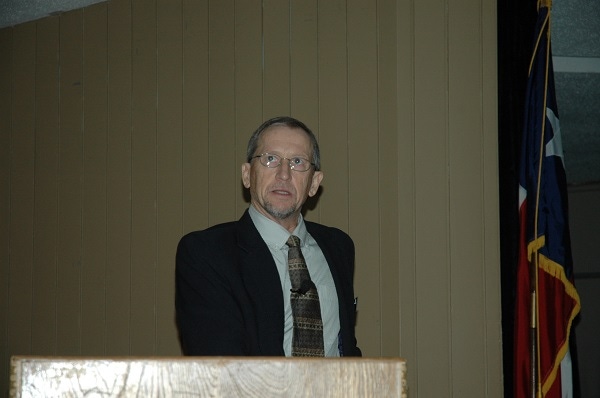
Soil testing offers farmers a proven means of evaluating soil nutrient levels and provides guidelines to help set fertilizer rates and application methods to achieve desired production levels.
Cooperative Extension agents have preached that sermon for about as long as the agency has been in existence. So why do so few Texas farmers take advantage of an affordable and proven system to increase efficacy?
“This could be an opportunity for substantial savings and reduced environmental impact,” says Dr. Mark McFarland, Texas A&M professor and AgriLife Extension soil fertility specialist.
McFarland, speaking at the Texas Plant Protection Association conference at College Station last December, said testing deeper than the typical 6 inches also offers opportunities to take advantage of “residual” nutrients, especially nitrogen.
“I see two compelling reasons to be interested in better soil fertility management,” he said. The first is to manage costs. “The last few years fertilizer prices have increased and fluctuated. Even with recent price drops, it’s still important to manage fertility.”
If you are enjoying reading this article, please check out Southwest Farm Press Daily and receive the latest news right to your inbox.
Nutrient management also affects the environment. “Water quality is important,” McFarland said. “Some 55 percent of the nation’s streams are considered ‘impaired.’ Agriculture is recognized as one of the contributors.” He said 47 percent of Texas streams are considered impaired.
Closer attention to nutrient application and use can help reduce those numbers. “When we harvest a plant we remove nutrients with the vegetation or nutrients are left on the soil with the stubble.”
Mobile nutrient
He said nitrogen is very mobile and “can get away from us.” But managing crop residue and fertilizer application can reduce loss. “From 40 percent to 80 percent of plant nutrients return to the soil through biomass. We remove the same pound of nutrient over and over.” Maintaining that biomass reduces the environmental risk.
“But weather is a wildcard. If a farmer doesn’t harvest a crop or harvests only part of a crop, the amount of nutrient used is reduced. We know that. That’s the reason for soil tests.”
Nutrients may be naturally occurring, decayed organisms and carryover from previous applications. Nitrogen is “typically the most expensive nutrient, is soluble and mobile.”
That’s why McFarland recommends sampling below the typical 6-inch level. “As the price of fertilizer went up, we started looking at nitrogen and other nutrients and how well plants could go down and pick them up.” They began analyzing deep sampling to determine the amount of residual nutrients at depth and how well plants could use those leftovers.
‘We sampled down to 48 inches and found significant carryover nitrogen—up to 200 pounds per acre—over a wide range of soil types, climate and crops.”
So the nitrogen is there, but how well can the plant get to it? Pretty well, McFarland said. “With a significant amount of residual nitrogen available, we found little advantage to add supplemental nitrogen.”
With support from Cotton Incorporated State Support funds, McFarland and others conducted trials for seven years. They found they could credit nitrogen residue down to 24 inches and reduce supplemental fertilization.
They found similar results for corn and grain sorghum. “But we can only realize those advantages if we sample below 6 inches. With cotton, using residual nitrogen also helps manage other inputs, such as plant growth regulators and harvest aids.”
He said placement is also important for phosphorus. “Placing phosphorus subsurface makes it more available to the plant with less potential for loss, so it’s an environmental advantage. We can reduce the broadcast rate by 50 percent with no impact on crop yield.”
But to gain these advantages, farmers have to take action. “You have to test,” McFarland says.
Application also matters for potassium, said Dr. Gaylon Morgan, Texas AgriLife Extension state cotton specialist. Morgan reported on trials established to determine and correct potassium deficiencies in cotton.
Morgan said potassium deficiency symptoms have become more frequent and more severe in recent years. Dry conditions mid-season and clay soils were cited as reasons for deficiency. “Nutrient input versus removal maps showed a net negative balance of potassium in the Central Blacklands and Gulf Coast regions of Texas,” Morgan said. “Crop mining,” was the culprit.
Higher yielding varieties, he said, also demand more potassium.
Research results show advantages with injected potassium. “We saw consistent responses from the injected application of potassium where soil levels were at or below 150 parts per million,” Morgan said. “At these responsive sites, cotton yields were consistently higher in the injected application. Cotton micronaire also increases with higher potassium rates.�”
Morgan said more work remains with four trials scheduled for 2014. “Also, we need to develop a rate response curve for injected application of potassium and modify rate recommendations as appropriate for injected potassium.”
Toby Hlavinka, vice president, American Plant Food Corporation, offered other incentives to manage nutrients in crop production. “China and the weather are our greatest challenges,” he said, even in a market that is currently stable, and with lower prices. Increased manufacturing capacity in the United States has contributed to a nutrient price reduction.
“The United States remains the biggest commercial importer, but that will change as new (U.S.) capacity comes on line. But markets can change rapidly and imports create volatility. No one wants to carry inventory and that will also change as increased production comes online.”
He said the industry is split. “We see a disconnect. Traders want one thing and producers and dealers want something else, consistency.”
He said urea has probably “seen the bottom and will be bid up into March. We could see a price increase.”
Also of interest:
Base fertility on soil testing
About the Author(s)
You May Also Like






